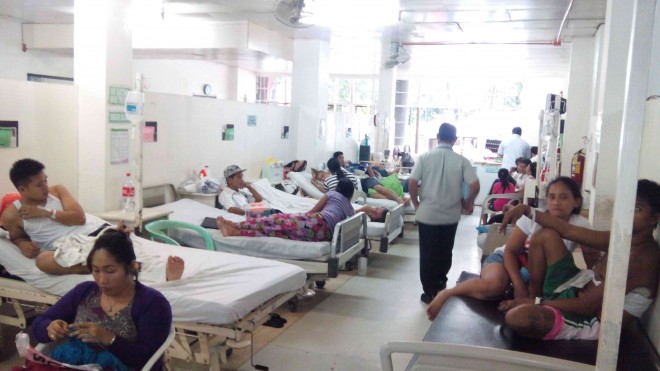Victor Morello went to the hospital on Monday to have his blood pressure taken after he felt dizzy while preparing lunch for his family in Barangay Parian, Cebu City.
But 10 people were already there at the outpatient department (OPD) of Cebu City Medical Center (CCMC) on Natalio Bacalso Avenue. “I have no choice but to wait because I don’t have money to go to a private hospital,” Morello, 39, said, fanning himself while sitting on a Monobloc.
The crowding of patients is a usual sight at the OPD of the city-run facility. At least 300 arrive every day, hospital chief Gloria Duterte said.
“We don’t turn away patients, especially in emergency cases, but there are times when they have to wait because we have other patients to attend to,” Duterte said.
Fewer admissions
After last year’s 7.2-magnitude earthquake badly damaged the old CCMC building, patient admission was reduced by more than half. The structure was declared unfit for occupancy, and hospital operations have since been transferred across the street, inside the compound of the regional Bureau of Fire Protection (BFP).
Medical facilities, wards and other hospital services occupy about 70 percent of the 7,000-square-meter lot where the BFP building stands. The gymnasium at the back of the two-story building has been converted into an obstetrics-gynecology and pediatrics ward.
A huge Red Cross tent shelters the patients and electric fans have been installed to provide ventilation. Hospital beds from the old CCMC building are still being used.
The adult ward is on the right wing of the BFP building’s ground floor.
Duterte’s office, the supply room and the administrative sections, among others, are on the left wing of the second floor. The three operating rooms and the emergency room share space with parked fire trucks. In the same area, cubicles are provided for patients to give them privacy.
The enclosed operating rooms are on the left side of the ground floor.
The imaging section, 2D echo and pharmacy are housed inside a container van placed near the BFP compound’s fence.
Only 98 beds
A reception area has been placed in front of the emergency room to accept inquiries and provide a sitting area for people accompanying patients.
Due to the limited space, bed capacity has been cut down to 98, Duterte said. Still, admissions would reach 108 per day.
Patients needing major surgery are referred to private hospitals or the government-owned Vicente Sotto Memorial Medical Center, Duterte said.
Because of the referral program, the P100-million budget for free medical assistance has been almost depleted, said Henry Sanchez, head of the city hospitalization and medicine program. As of Sept. 30, only P39 million had been left.
Under the program, a maximum of P25,000 in medical assistance is given to a qualified patient, Sanchez said.
Status downgrade
The Department of Health (DOH) has downgraded CCMC’s status from Level 3 to Level 1 since July due to the absence of a fully operational intensive coronary care unit (ICCU). The ICCU is supposed to give high-risk coronary patients access to special procedures such as intra-aortic balloon, heartbeat regulation, hemodynamic monitoring and cardioversion for arrhythmia.
A Level 1 hospital, according to the Department of Health’s Administrative Order No. 2012-0012 issued on July 18, 2012, must be able to provide minor surgical services. A Level 2 hospital must have an intensive care unit and departmentalized services and equipment to be able to provide services in specialized fields, such as pediatrics and obstetrics-gynecology.
A Level 3 hospital should have residency or teaching programs and an ICCU and can also perform major surgeries.
The DOH classification is based on service, manpower, equipment and infrastructure, Duterte said. She said the city had to work to regain the Level 3 classification.
Duterte said the pediatrics, internal medicine, surgery, obstetrics and other departments continued to operate.
Dream hospital
Even if the hospital shares a space with the BFP, it still receives an annual budget of P300.7 million from the city government. Of the amount, P197.7 million goes to the salaries of about 400 personnel, including 33 physicians on training, while the rest is for maintenance and other operating expenses, including the P40-million allocation for drugs and medicines and P150,000 for the daily sustenance of patients computed at P15.67 per meal.
A year after the earthquake, Mayor Michael Rama’s dream to have a “world-class hospital” to replace the 45-year-old CCMC has remained as such. The site of the old hospital building remains fenced off and empty.
“You better ask the national government, what are they doing [to help the city]? It’s not a question of one year, but has there been movement?” Rama said.
The city government needs P1.5 billion to build a 10-story, 409-bed-capacity hospital that Rama wanted. So far, only P316 million has been raised, and P300 million of the amount came from the 2014 Supplemental Budget 1 while the rest was donated.
The funds will mainly be used for the Phase 1 of the project, which entails laying down the foundation before the year ends.
Pledges
Rama has initiated a “Piso Mo, Hospital Ko” campaign to raise money for the city hospital’s reconstruction. He has received P912 million in pledges, some coming from Cebuano communities abroad he had visited last year. Not a single centavo has been collected from the pledges, however.
Rama asks Cebuanos to be patient. “This administration will not stop [looking for funds] until the hospital’s construction is completed,” he said.
But when, he cannot say.
